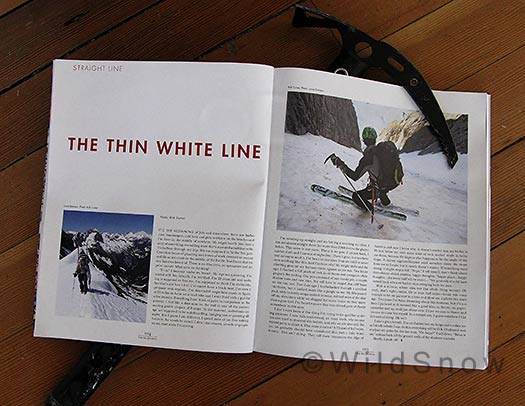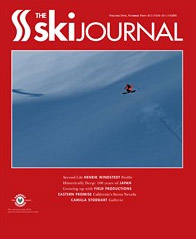Real publishing (not that easy web stuff anyone can do) now runs in the Dawson family. Ski Journal 5.2 has a gripping and well written article by PNW ski alpinist Kirk Turner, with a classic extreme ski shot taken by WildSnow progeny Louie, as well as a hero shot of the young man himself. Lisa and I are shopping for picture frames already, and getting wallet versions made. First print published photo by the guy, and congrats Kirk on getting your writing in there.
Only, I didn’t know that couloir Kirk and Louie skied was 2,000 feet of ice, some at 65 degrees. Not sure what to think about that, only that I now feel bad about what I put my own mom and dad through.

Thread of Ice article by Kirk, shot of Louie on left, Louie shot of Kirk on right.
In any case, good job Louie and Kirk, both on pulling off the safe second ascent and first ski descent of Thread of Ice, but also documenting your adventure in what is hands down the best ski publication in existence. More, nice to see ski shots where trick posing was the last thing on the practitioner’s mind. Or, did you do a front flip off that first 65 degree bulge, on belay?
Um, now I’m trying to remember what else is in this ish. Oh yeah, nice coverage of alpinism in California Sierra that includes the admission that 4-wheeling is in our DNA, something cool with Japanese skiing history and a weird photo of a monkey face, and some guy named Henrick Windstedt. I’ll have to look at those articles again. That is after I find a color copy machine so I can run off 300 copies of Kirk’s article, and do a bulk mailing to all our relatives.
Three WildSnow thumbs up. Or is that get more curved pick tools boys, and keep your skis tuned?
WildSnow.com publisher emeritus and founder Lou (Louis Dawson) has a 50+ years career in climbing, backcountry skiing and ski mountaineering. He was the first person in history to ski down all 54 Colorado 14,000-foot peaks, has authored numerous books about about backcountry skiing, and has skied from the summit of Denali in Alaska, North America’s highest mountain.

